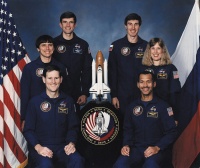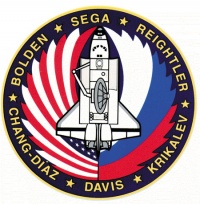STS-60
From The Space Library
 | |
| Organization | NASA-OfficeofSpaceFlight(UnitedStates) |
|---|---|
| Mission type | Human Crew |
| Launch date | February 3, 1994 |
| Launch vehicle | Space Shuttle |
| Launch site | Cape Canaveral, United States |
| COSPAR ID | 1994-006A |
| Experiments | Here |
| Alternate Names | 22977 |
| Additional Information | Here |
| Data Collection | Here |
| Payload Mass Up | 13006.0 kg |
STS 60 was a US shuttle mission launched from Cape Canaveral. On board was the Spacelab-02 facility to conduct 12 experiments. Among them were the following four GAS (Get-Away Special) microgravity experiments: G-536--Pool Boiling experiment; G-557--Capillary Pumped Loop experiment; G-071--Ball Bearing experiment; and G-514--Orbiter Stability experiment. It also carried resources for high school/college science experiments. The shuttle released six mini-targets (EDERACS A-F) to provide radar calibration, and a Germany mini-satellite, BREMSAT. Repeated efforts to deploy a three-meter diameter, retrievable shield (Wake Shield Facility) behind which pure crystals of Gallium Arsenide were planned to be grown were unsuccessful. Leading the six-person STS-60 crew was Mission Commander Charlie Bolden who made his third space flight. The Pilot for the mission was Ken Reightler. Mission Specialists included Jan Davis, Ron Sega, Franklin Chang-Diaz, and Sergei Krikalev, who was a veteran of two flights in space, both long- duration stays aboard the Russian MIR space station. Krikalev's flight aboard the shuttle was the beginning of a three-phased program of cooperative efforts between the US and Russia. Phase one entailed up to 10 Space Shuttle- MIR missions including rendevous, docking and crew transfers between 1995 and 1997. Phase two is the joint development of the core Internation Space Station (ISS) program. Phase three will be the expansion of the space station to include all the the international partners.

